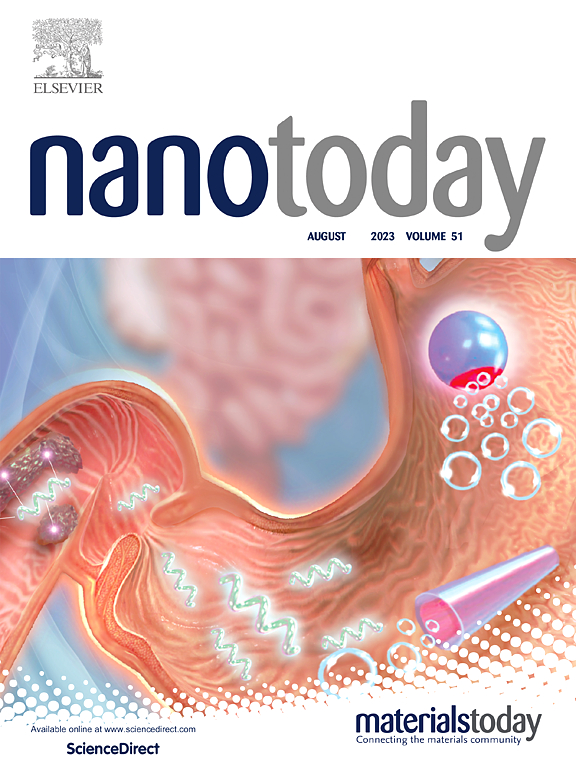一种酶激活和结构可转化的超分子溶瘤肽,通过全身给药,用于有效的癌症免疫治疗
IF 13.2
1区 材料科学
Q1 CHEMISTRY, MULTIDISCIPLINARY
引用次数: 0
摘要
溶瘤肽已成为一种很有前途的溶瘤治疗药物。然而,溶瘤肽在系统给药时面临许多挑战,包括非靶向毒性、生物活性差和稳定性不足。我们在这里提出了一种创新的策略来开发适合全身静脉注射的自组装超分子溶瘤肽。D2RP (Nap-GDFDFDY-RR-DKRFYVVMWKDK)包含并显著赋能PKHB1 (DKRFYVVMWKDK;(CD47的内源性配体)具有强大的溶瘤活性,通过自组装成带正电荷和富含α-螺旋的膜裂解纳米原纤维。随后,D2RP在DY4和Y10位点磷酸化的两种前体pD2RP (Nap-GDFDFpDY-RR-DKRFYVVMWKDK)和D2RpP (Nap-GDFDFDY-RR-DKRFpYVVMWKDK)分别被定制,以碱性磷酸酶(ALP)响应的方式生成溶膜纳米原纤维。pD2RP和D2RpP都具有生物相容性,但它们预先组织成不同的状态,并进行不同的去磷酸化过程,以产生不同的超分子结构和溶瘤活性的膜裂解纳米原纤维。在机制上,pD2RP和D2RpP在去磷酸化之前保持无活性;此时,它们到达富含alp的肿瘤病灶后,通过结构重构激活膜裂解活性。当静脉给药时,pD2RP通过诱导更有效的免疫细胞死亡和唤起强大的全身抗肿瘤免疫反应,在肿瘤排斥方面优于D2RpP。本研究为体外静脉给药定制超分子溶瘤肽提供了新的范例,并为优化其抗肿瘤功效提供了有价值的策略。本文章由计算机程序翻译,如有差异,请以英文原文为准。
An enzyme-activated and structural transformable supramolecular oncolytic peptide for efficient cancer immunotherapy through systemic administration
Oncolytic peptides have emerged as a promising oncolytic therapeutic. However, oncolytic peptides face numerous challenges when administrated systemically, including untargeted toxicity, poor bioactivity, and inadequate stability. We here present an innovative strategy to develop self-assembled supramolecular oncolytic peptides suitable for systemic intravenous administration. D2RP (Nap-GDFDFDY-RR-DKRFYVVMWKDK) comprises and significantly endows PKHB1 (DKRFYVVMWKDK; an endogenous ligand of CD47) with powerful oncolytic activities by self-assembling into positive-charged and α-helix-enriched membrane-lytic nanofibrils. Subsequently, two phosphorylated precursors of D2RP at DY4 and Y10, namely pD2RP (Nap-GDFDFpDY-RR-DKRFYVVMWKDK) and D2RpP (Nap-GDFDFDY-RR-DKRFpYVVMWKDK), respectively, are tailored to generate membrane-lytic nanofibrils in alkaline phosphatase (ALP)-responsive manner. Both pD2RP and D2RpP are biocompatible, while they preorganize into different states and proceed with varied dephosphorylation processes to generate membrane-lytic nanofibrils differing in supramolecular structures and oncolytic activities. Mechanistically, pD2RP and D2RpP remain inactive until dephosphorylated; at this point, their membrane-lytic activities are activated through structural reconfiguration upon reaching the ALP-enriched tumor lesions. When administrated intravenously, pD2RP outperforms D2RpP in tumor rejection by inducing much more potent immune cell death and evoking robust systemic anti-tumor immune responses. This study provides a new paradigm for tailoring supramolecular oncolytic peptides for systemic intravenous administration and a valuable strategy for optimizing their anti-tumor efficacy.
求助全文
通过发布文献求助,成功后即可免费获取论文全文。
去求助
来源期刊

Nano Today
工程技术-材料科学:综合
CiteScore
21.50
自引率
3.40%
发文量
305
审稿时长
40 days
期刊介绍:
Nano Today is a journal dedicated to publishing influential and innovative work in the field of nanoscience and technology. It covers a wide range of subject areas including biomaterials, materials chemistry, materials science, chemistry, bioengineering, biochemistry, genetics and molecular biology, engineering, and nanotechnology. The journal considers articles that inform readers about the latest research, breakthroughs, and topical issues in these fields. It provides comprehensive coverage through a mixture of peer-reviewed articles, research news, and information on key developments. Nano Today is abstracted and indexed in Science Citation Index, Ei Compendex, Embase, Scopus, and INSPEC.
 求助内容:
求助内容: 应助结果提醒方式:
应助结果提醒方式:


